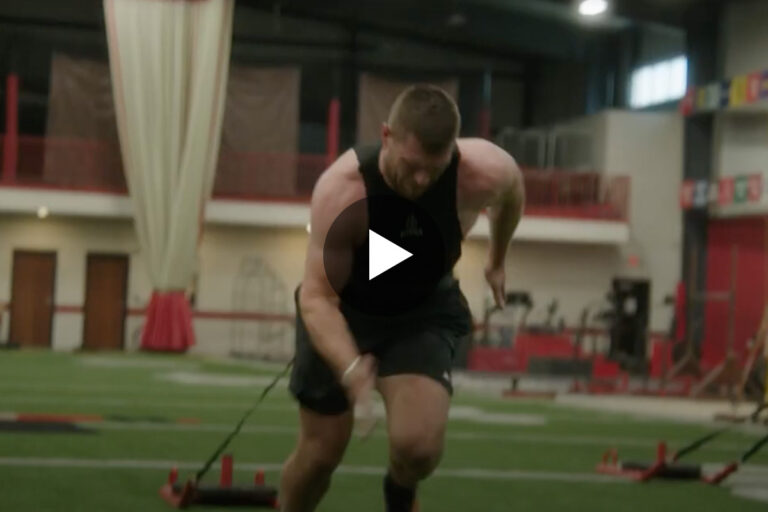The game of football tends to have one of the highest injury rates in sports and is considered one of the most dangerous sports to play for 15- to 24-year-olds. While injuries are considered a common part of the game due to the size of the players, the speed of play, and the physical nature of the game, there are certain things that you can do to reduce the odds of getting injured during a practice or a game.
Some of the top injury prevention tips for football players are to perform proper warm up and cool down routines before and after practices and games, consistently incorporate strength training and stretching into your regular fitness program, and always speak with a sports medicine professional or athletic trainer if you think you might have gotten injured.
Since warming up, cooling down, and stretching before and after training sessions, practices, and games is one of the best ways to prevent certain football injuries, let’s take a closer look at the best stretching exercises for football players.
Stretching For Football Players
Not only will a good stretching program help to prevent injury, it can also help to minimize muscle imbalances and improve your performance on the field. The best time to stretch is when your muscles are warm and relaxed. So, before you begin your stretching routine, do a general body warm up (light running) for five to 10 minutes. Then you can start stretching.
Dynamic Stretching For Football Players
Football is a dynamic sport. That’s why dynamic stretching, or stretching while moving, is so important for football players. This form of stretching improves speed, agility, and acceleration and is a good way to warm up your muscles by doing moves that are similar to the motions that you’ll be doing soon on the football field. Start first with slow, low intensity movements and then gradually progress to full speed football-like movements.
Dynamic Stretches
Walking Knee Hugs: A variation to walking high kicks and walking high knees, walking knee hugs will improve hip mobility while increasing flexibility in your glutes and hamstrings. To do walking knee hugs, stand tall with your legs straight and your arms hanging at your sides. Then kick one knee up, bringing it as high as comfortable. Grasp your knee with both hands and pull it up slightly higher, hugging your knee to your body. Then slowly repeat with your opposite side. Each step should move you forward a little bit. Perform ten repetitions.
Dynamic Lunge with Rotation: Football players often have tight hips. This Dynamic Lunge with Rotation stretchhelps to increase hip mobility for better sprinting power and it will also help with your thoracic spine mobility. In the lunge position, have your back leg’s arm rotate up and back approximately 135 degrees. While doing this, have your head follow your hands and keep your feet facing forward. You’ll feel a stretch in the front of your hips and your chest. Do 10 repetitions.
Frankenstein Walk: The Frankenstein Walk is a good way for football players and runners to stretch their hamstrings. To do the Frankenstein Walk, hold your arms out straight in front of your body. While keeping both of your legs straight and rigid, bring your right leg up toward your right hand. Then place it back on the floor. Next, lift your left foot up toward your left hand, while keeping your legs as straight as possible. Start walking as you alternate leg kicks to help facilitate hamstring flexibility.
90/90 Stretch: To open up your torso and the muscles of your middle and upper back, which are key areas for football players, do the 90/90 Stretch. Lie on your left side with your legs stacked and your knees bent to 90 degrees. Hold a towel between your knees. Then while maintaining pressure on the towel and keeping your hips still, rotate your chest and right arm back to the right, while trying to put both shoulder blades on the ground. Hold the stretch for at least two seconds and then return to the starting position. Do 10 reps per side.
Static Stretching For Football Players
Static stretches should be used as part of any football player’s cool down routine to help increase flexibility and prevent injury. Static stretching is mostly performed as a passive stretch where the muscle is not active and is stretched by external forces. You should try to hold static stretches for 20 to 45 seconds and aim to repeat static stretches two to three times each.
Static Stretches
Posterior Capsule Stretch: This stretch is for the back of your shoulder and is beneficial for quarterbacks and any athletes who play throwing sports. To do the Posterior Capsule Stretch, relax your shoulders, bring one arm across your body, and hold it with your other arm just above your elbow, while pulling gently toward your body.
Hamstring Stretch: Football players need to be able to run up and down the field and from side to side. One of the ways to prevent injuries while running is to stretch your hamstrings after training sessions. This hamstring stretch can even be done from the comfort of your own home immediately following practice. Place one leg on a low stool with your hips and feet facing forward. Lean forward from your hips, while keeping your back flat and your knee straight until you feel a stretch in the back of your thigh.
Squatting Leg-Out Groin and Adductor Stretch: To prevent a groin strain, which typically occurs as a result of a sports injury or an awkward movement of the hip joint, do this Squatting Leg-Out Groin and Adductor Stretch. Stand with your feet wide apart. Keep one leg straight and your toes pointing forward while bending your other leg and turning your toes out to the side. Lower your groin toward the ground and rest your hands on your bent knee or the ground.













